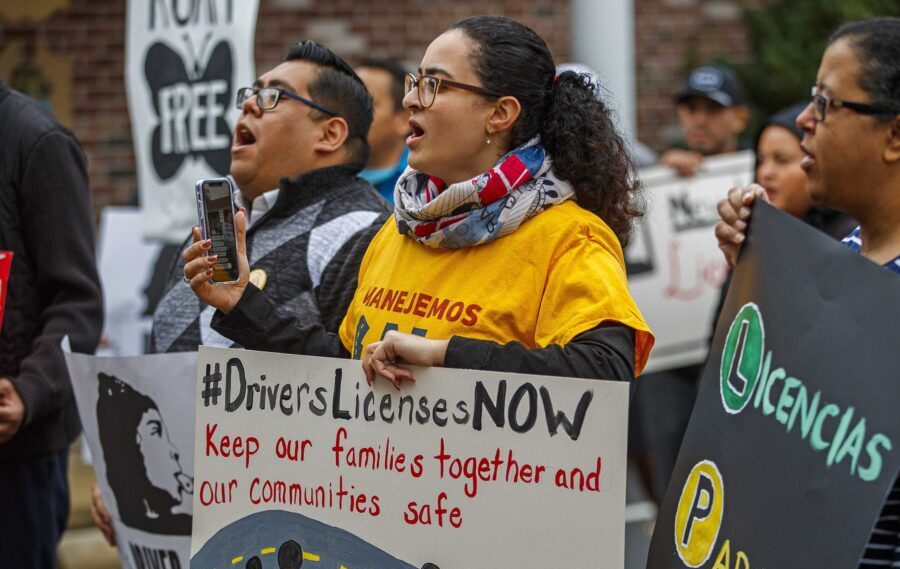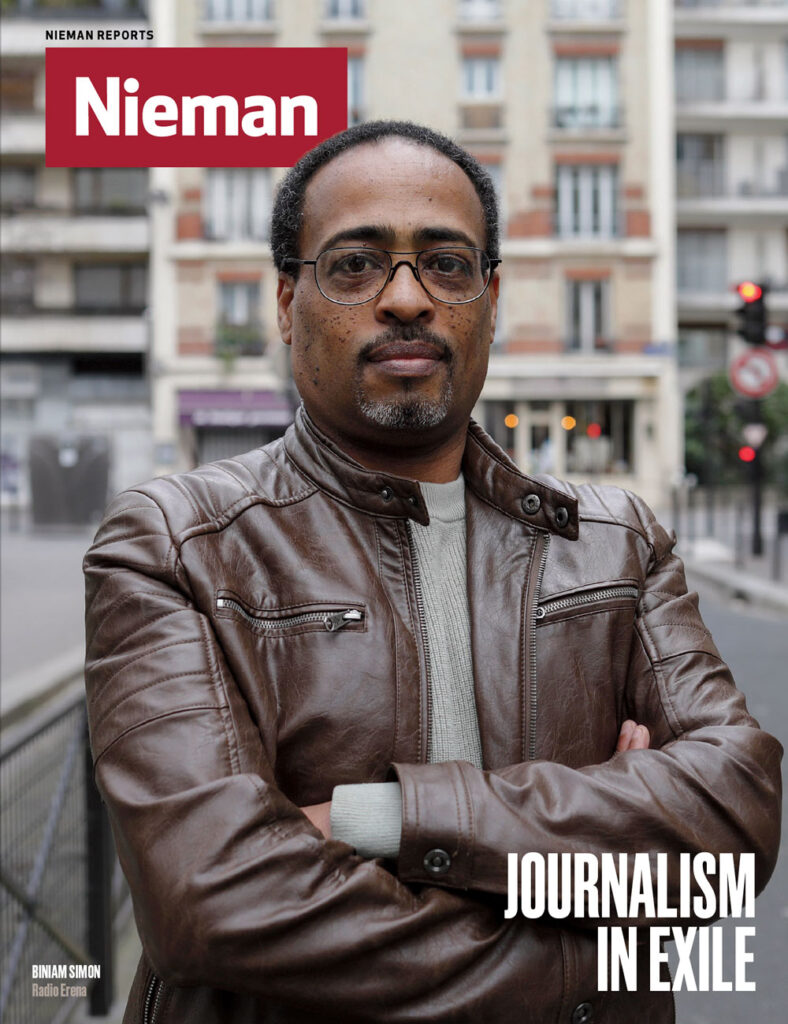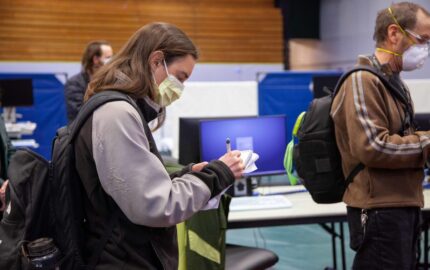On Sept. 6 of last year, California Gov. Gavin Newsom signed California Assembly Bill 179 into law and, with it, dedicated $25 million to funding local reporting in places underserved and underrepresented by the press in the state. The money — the largest state-level public investment in local news in history — will be distributed through a fellowship program housed at UC Berkeley’s Graduate School of Journalism and is hailed by advocates as a much-needed cash infusion for an industry that provides a public service for state residents, but has seen 115 newspapers close over the last two decades.
The fellowship program through Berkeley is intended to help bolster local reporting and close the gaps in coverage. The goal is, by 2025, to put 120 journalists in the field for three-year terms. These “journalists will be completely independent and operate without any connection to the government or influence from politicians,” says State Sen. Steve Glazer, co-sponsor of the legislation. “[W]e think the fellowship program is a model that can and will be replicated across the country.”
California isn’t the only state testing public policy as a strategy for supporting equitable local news. Amidst an existential crisis in local journalism and the failure of the federal government to pass legislation, state-level experiments designed to support local journalism as a crucial public service are expanding, from New Jersey to California, New Mexico to Wisconsin, Illinois to Washington, and beyond. The approaches vary from state to state — in New Jersey, for example, lawmakers have set up a consortium to distribute public funds to new organizations; others are considering tax incentives to help keep newsrooms afloat — but the goal is largely the same: to innovate around different public funding models to help fill the hole left by shuttered news organizations.
Over the last two decades, about 2,500 local news operations have closed — more than 360 of them in the last three years under additional Covid-19 pressures. Roughly 70 million people live in a news desert — defined as a community that has one or no newspaper available or a place where residents don’t have access to fact-based local news and information. Those hardest hit — the rural, poor, and communities of color — are left disproportionately cut off from quality local reporting, like coverage of their school board, for instance, or Covid-19 or other public health updates, or how the town government is spending their tax dollars.
Related Posts
Despite the disruption, public investment in local news remains woefully low, in the U.S. especially, where only $3.16 per person is spent on public media, most of which goes to the Corporation for Public Broadcasting (CPB) to support local public television and radio stations, the affiliates that often carry NPR and PBS programming. For comparison, Germany spends more than $142 per capita while Botswana spends $18.38 per person.
Broad public awareness of the collapse of local news in the U.S. is likewise scarce. According to a 2019 Pew research study, 71 percent of Americans actually believe their local news outlets are “doing well financially.” Without more public pressure to address the problem, passing meaningful policy is just that much harder. Yet, as supporters of public policy solutions recognize, and, as a 2019 Gallup/Knight study found, 86 percent of American adults believe everyone should have access to local news. Six in 10 “consider the local newspaper in their community an important symbol of civic pride,” Gallup/Night found. But this trust is fragile, with only 29 percent of Americans surveyed saying they trust the news, placing the U.S. at the bottom of the 46 countries surveyed in 2021 by the Reuters Institute for the Study of Journalism.
Given the gridlock in D.C., it’s unlikely that Congress will pass significant federal funding or meaningful reform for local journalism anytime soon. The Future of Local News Act, introduced by Democrats in May of 2021, aimed to create a 13-member panel to study the complex landscape and recommend ways Congress can act, but looks like it’s going nowhere. Likewise, the Local Journalism Sustainability Act, which would have allocated $1 billion for local journalism, died along with the Build Back Better bill. It would have supported local journalism in three key ways: by giving individuals up to a $250 tax credit for paying for a local news subscription; a tax credit of up to $5,000 for small businesses to advertise with local outlets; and a payroll tax credit for news organizations to help them hire and keep staff. With Republicans having retaken control of the House of Representatives, the window has likely closed to pass the Journalism Competition and Preservation Act, which would allow larger outlets that earn more than $100,000 per year to negotiate with or sue tech giants like Meta, Twitter, YouTube, and Google for compensation for use of their news products. (One obvious place to start, sources say, would be to update the Corporation for Public Broadcasting, which is federally funded and already delivers programming to households around the country through local television and radio stations, though the money allocated to the entity in the fiscal 2025 budget falls short of its funding request by about $30 million.)
Yet, there is long-standing precedent for federal support of journalism, says Harvard legal scholar Martha Minow, author of “Saving the News: Why the Constitution Calls for Government Action to Preserve Freedom of Speech.” In 1792, the Postal Service Act subsidized newspaper access nationwide. And it was the government that issued the first transcontinental telegraph rights in the 1860s to public lands. It also instituted federal requirements that cable service carry local stations as well as mandates for public educational broadcasting and universal telecom service.
Public policy, whether at the federal, state, or local level, isn’t the only, or even the most stable, long-term strategy for saving and sustaining local news long-term, nor for creating a truly equitable news landscape, Minow and other sources are quick to say. Innovation involving the tech sector, universities, libraries, advertisers, donors, subscribers, or events are others. In particular, sources say, the growth in philanthropy is notable. According to Sue Cross, executive director and chief executive officer of The Institute for Nonprofit News, the number of nonprofit newsrooms doubled from 2017 to 2021. INN is projecting the number to reach more than 600 by 2026. Since 2019, The American Journalism Project has raised $37 million and funded 33 news operations, for instance.
But these important funding strategies alone, so far, are struggling in a number of ways. In its “Index 2022: The State of Nonprofit News,” INN reported, “Foundation funding, a major fuel supplier for public service journalism, remains concentrated in the larger, national and global news outlets – and remains elusive for smaller, local organizations.” For instance, only about five percent of philanthropic dollars disbursed between 2010 and 2015 reached local news organizations, according to the University of North Carolina and The Knight Foundation. Of the estimated 400 local news sites launched in communities that lost a newspaper in the last 15 years, “only two of the outlets are in the 171 counties in the U.S. that have no newspaper,” the study concludes. And only a small fraction of those dollars went to newsrooms supporting communities of color and economically disadvantaged areas. The Democracy Fund estimates that of the $1.2 billion in journalism grants disbursed between 2009 and 2015, only six percent “went towards efforts serving specific racial and ethnic groups” and only seven percent “went towards efforts serving economically disadvantaged populations.” However, there are some organizations working to change this. Nancy Lane, CEO of the Local Media Association and Local Media Foundation, a nonprofit working with some 3,000 local media operations, notes that last year 47 percent of her organization’s philanthropic funding — or nearly $3.9 million — went to “programs focused on reaching specific racial, ethnic or LGBTQ+ communities.”
If the public values local journalism, if local journalism is a public good, and if there is a long tradition of public policy in support of journalism, advocates say we must push harder on public policy strategies in response to the crisis. In the absence of a viable business model, they argue, local journalism deserves public support, whether from direct financial funding, tax assistance, or other approaches, in addition to these other critical, evolving means. The impasse at the federal level means that states find themselves in a position to test solutions of their own, says Minow, citing an observation Supreme Court Justice Louis Brandeis made almost a century ago: “It is one of the happy incidents of the federal system that a single courageous state may, if its citizens choose, serve as a laboratory; and try novel social and economic experiments without risk to the rest of the country.”
Here are some states doing exactly that.
California
In California one mid-November afternoon, Christa Scharfenberg, project director for the California Local Journalism Fellowship Project, took time for a call. It’d been barely two months since Newsom had signed off on $25 million for the fellowship program at Berkeley, and Scharfenberg, who’d come from the American Journalism Project, was busy.
In the few weeks she’d been on board, she’d already met with leaders “all over the state,” from The Los Angeles Times and McClatchy and KQED to mid-sized and small operations like The Press Democrat in Santa Rosa and El Tímpano in Oakland, to nonprofits like Cal Matters. Since then, she’s also met with ethnic media outlets, journalism heads at community colleges, and smaller nonprofits around the state, she says, to build awareness, solicit feedback, and answer their questions about the program.
The project will prioritize small and undercapitalized organizations, but with public funding, says Scharfenberg, “there’s an imperative that out of the gate, it’s for all of California.” She notes that bigger organizations “are interested in supporting smaller markets,” perhaps by providing a source of centralized editing support or coordinating reporting for the project's fellows.
“More journalists for us means there will be fewer of our stories left untold, more reporters to hold our elected officials and public servants accountable, and more facts in the public conversation to combat the current plague of disinformation that challenges all our communities.”
— Paulette Brown-Hinds, president of Black Voice News
Scharfenberg is developing the application process for both news organizations and fellows with the goal of making it easily accessible for under-resourced newsrooms, a key to promoting equitable distribution, she says. There also will be a rigorous research and assessment component to the program, and, to help guarantee fellows a long and sustainable journalism career, an on-campus training, support, mentorship program. Fellows will be UC employees and receive a starting compensation package of $65,000 including benefits. (Newsrooms will contribute between $5,000 and $25,000 a year, depending on the size of their budget.) If all goes well between the newsroom and the fellow, there would be a path to a third-year renewal for 10 to 15 fellows in each cohort.
Newsroom leaders in the state, like Paulette Brown-Hinds, president of Black Voice News, an online publication based in Riverside, see the program as an opportunity to expand their staffs and improve coverage: “More journalists for us,” says Brown-Hinds, “means there will be fewer of our stories left untold, more reporters to hold our elected officials and public servants accountable, and more facts in the public conversation to combat the current plague of disinformation that challenges all our communities.”
When asked to address skeptics who say 120 journalists over three years is a small gesture in a state as vast as California, Steve Katz, Berkeley’s journalism school’s assistant dean, argues that you have to start somewhere. “We have heard this argument, ‘It’s a drop in the bucket. It doesn’t address monopoly,’” he says. “I don’t accept that if we don’t solve all the problems, we aren’t doing something important.” In 2009, he points out, the Institute for Nonprofit Journalism had 27 founding organizations; today, there are more than 400.
New Mexico
In New Mexico, Rashad Mahmood, executive director of the New Mexico Local News Fund (NMLNF), doesn’t accept those criticisms either. Mahmood, who has worked as a journalist in Egypt and a program coordinator for Generation Justice, a youth advocacy group, and for public radio station KUNM’s Public Health New Mexico reporting project, is looking to use public policy to double NMLF’s fellowship and internship program funds, used to pay recent graduates to work in local newsrooms for nine months at a time. The fellowship to date has placed 16 journalists, most of whom have remained in journalism in New Mexico, Mahmood says. They have covered student protests for better pay and insurance benefits at UNM in Albuquerque, the state’s launch of a new digital program designed to help families find child care, 2022 Picuris Pueblo Tribal Council election results in Taos, and midterm election results in Las Cruces and Doña Ana County, to name just a few examples.
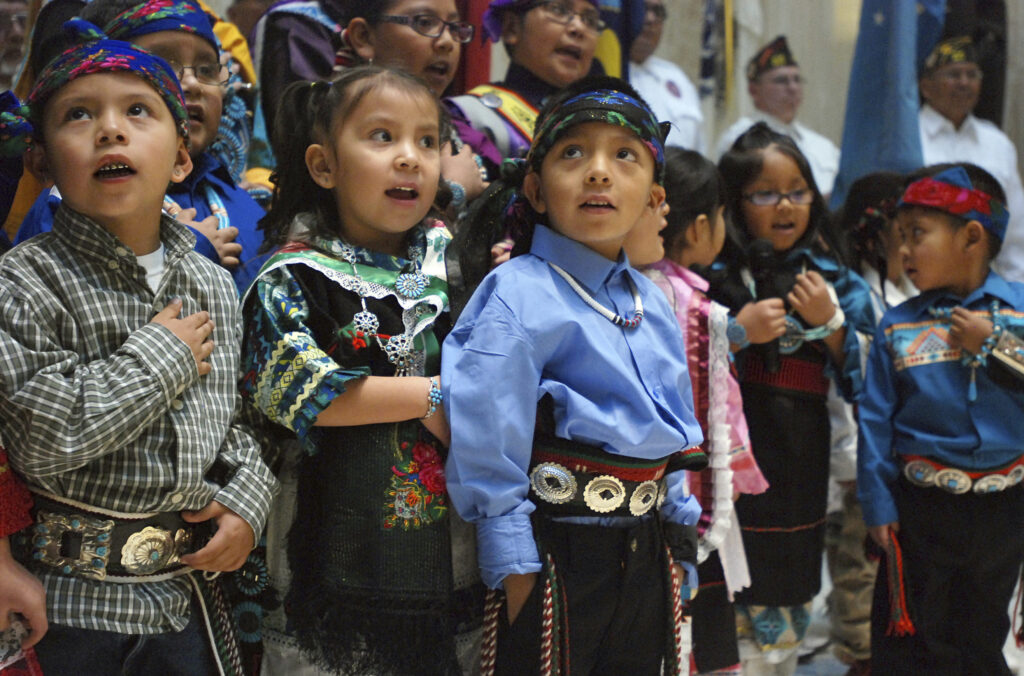
In an October column for The Santa Fe New Mexican, headlined “$25 million California appropriation will aid N.M. news,” Mahmood called for widespread public support. In January, New Mexico’s Senate Majority Leader Peter Wirth introduced a bill that would set aside $200,000 to fund a local news fellowship program in 2024. The funding could support newsrooms like KUNM, the public radio station housed at the University of New Mexico. KUNM has hosted NMLNF fellows, but the state funding would allow the station to cover stories across the state and help train the next generation of journalists in New Mexico. “It might allow us to access additional funds for training and conferences,” says Megan Kamerick, KUMN’s news director. “It could also help us add more staff. All these things are very challenging for us to fund as a small public radio station.”
Their current NMLNF fellow Jeanette DeDios has covered the need for funding for Bureau of Indian Affairs (BIA) schools like the To’Hajiilee Community School; impacts of the Indian Child Welfare Act on Native American children in New Mexico; and the importance of training law enforcement on how to identify potential Native American human trafficking victims.
New Mexico has more Native American representation than many other states, observes DeDios, a Native woman from the Jicarilla Apache and Navajo Nations, “but they still lack basic healthcare, education, and proper living conditions.” DeDios’ reporting, she and Kamerick say, brings new and important coverage and attention to the issues Native Americans in New Mexico “face on a daily basis.”
In addition to California, Mahmood credits another state, New Jersey, for the cascade effect its early trailblazing has inspired, by “raising the profile for the potential of state and federal support for local news.”
New Jersey
In 2018, legislators passed the landmark New Jersey Civic Information Bill, making New Jersey the first U.S. state to pass policy in support of local news in crisis and allocate tax dollars for news outlets. It had taken coalition activists, led by Free Press, a nonprofit advocacy organization, some four years to get there. The bill created a 16-member non-profit consortium, called the New Jersey Civic Information Consortium, charged with distributing the public funds “with the mission,” according to Free Press, “of strengthening local-news coverage and boosting civic engagement in communities across the state.” The nonprofit is, in the words of Mike Rispoli, senior director of journalism policy at Free Press, “a first-of-its-kind” in the U.S.
To ensure a firewall between government and public interest, the bill requires the Civic Information Consortium to be comprised of representatives from universities, media outlets, community groups, journalists, local organizers, and students. True, Rispoli says, “it’s ridiculous” how unwieldy the process of determining who receives public funds can be with an interdisciplinary, inclusive 16-member nonprofit board. But the board is designed to ensure equitable distribution of the $3 million in New Jersey’s 2023 Civic Information Fund. Today, 14 local news organizations are using New Jersey’s public funds.
To be eligible, applicants are required to partner with a collaborating university and demonstrate a clear benefit to the community. Rispoli says that could mean hiring a journalist for a specific beat, but it could also mean starting a training program for local journalists or launching an entirely new outlet. One recipient, Movimiento Cosecha, a national volunteer-based nonprofit, received $85,000 over two years to work in partnership with Rutgers to create Radio Cosecha NJ, a Spanish-language radio station to serve New Jersey’s Spanish speaking population that launched in January 2022. The station has covered social unrest in Peru, the governors board meeting at Rutgers, Covid-19 health information, and instruction on how to obtain drivers licenses.
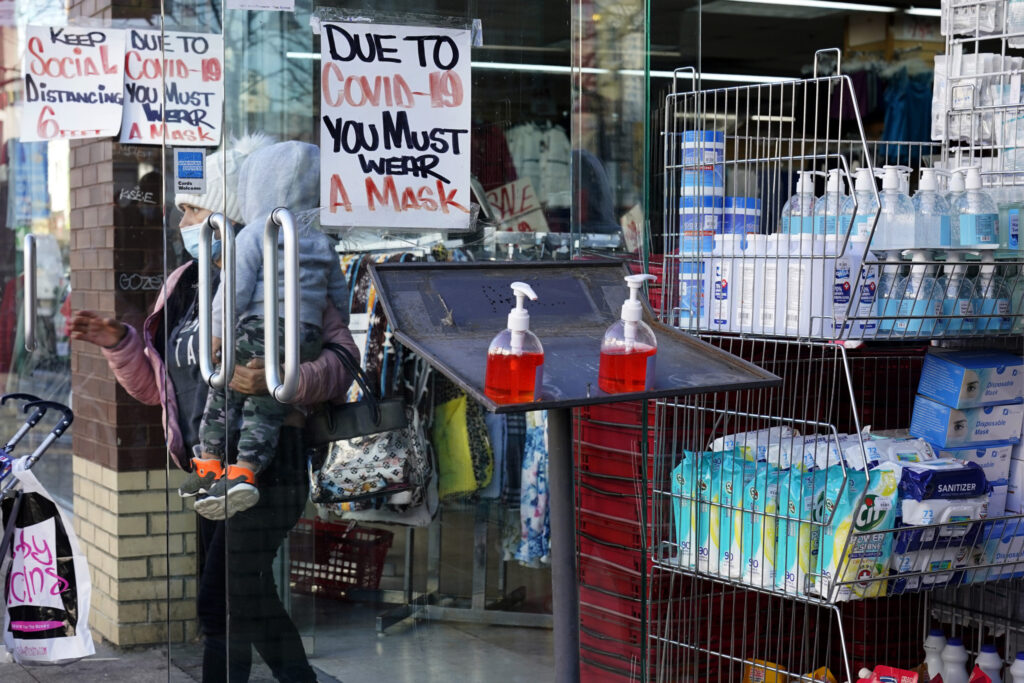
The outlet also helped advertise Movimiento Cosecha’s 70 clinics to support people trying to access money New Jersey set aside for its residents who were not eligible for federal stimulus checks or Covid-19 relief funds because of their immigration status. “A lot of the community didn’t know it was available,” says Carlos Castaneda, Radio Cosecha’s director. Because applicants had trouble reaching state officials with questions about the program, which required detailed personal information to apply, many felt like the program was a scam, he adds. With Radio Cosecha advertising the clinics, which helped an estimated 700 people file for the funds, “they felt more trust.” The money from the Civic Information Fund “has helped us amplify the needs of the community, but also the community’s resilience” and is allowing the station to purchase a vehicle that will serve as a mobile studio.
The Newark News and Story Collaborative, a nonprofit partnership between WBGO-Newark Public Radio, Free Press, and the Center for Cooperative Media, was founded in 2020 with the help of $110,000 in state funds “to dive deeper into the information needs of Newark residents as we faced the onset of the coronavirus pandemic,” says Brit Harley, NNSC’s co-founder. Since its founding, the collaborative has launched Five Wards Media, an online outlet covering Newark, and has hosted 200 conversations and community forums. It has covered how to sign up for and speak at local council meetings, and is providing ongoing reporting on citywide council meetings, local LGBTQ events, local food systems, access to public land, a nurse and medical technicians’ strike for better working conditions and contracts, and racial justice and policing. NNSC’s Covid-19 resource guide has reached some 10,000 people, and 44 residents to date have participated in its community media lab program, which trains and pays Newark residents to learn journalism and storytelling skills. The impact of this work is clear, Harley says: “Residents now identify us as a space where they can share their stories and lived experiences.”
The nonprofit Stories of Atlantic City (SOAC), a collaborative model that partners with community groups, existing media outlets, and government agencies, has used its public funds — nearly $100,000 over two years — to create a seven-month training course at Stockton University. The program teaches residents how to report on local government entities like the city council, the school board, and the Casino Reinvestment Development Authority. The first cohort included 17 community members, a multilingual and cross-generational group, from backgrounds in social work, health care, education, the arts, and other sectors.
“Getting the grant enabled us to work on projects we’d dreamed about, but didn’t have support for,” says Christina Noble, SOAC’s inaugural project manager. Beyond SOAC’s reporting, the training fellows took away is important, Noble says. They learned how government works, the basics of journalism, and how to ask the right questions. All of this is shared beyond SOAC, with friends, family, colleagues, neighbors, she adds.
SOAC fellow Shalini Basu, a social worker and first-generation immigrant who grew up in Atlantic City, has used this training to cover veterans’ housing issues and food drives. “Atlantic City overall has a very negative image” in the news, Basu says, fed by media that isn’t local and doesn’t understand what day-to-day life is like in this coastal city of nearly 39,000 people. “We live and work in this community every day. Real people live here. We have a thriving art scene, a community where people look out for each other.” After years of leaving, young people are starting to come back and invest in local businesses, she says, adding that SOAC’s coverage touches on the full range of experiences in Atlantic City.
Other States
States are testing a range of strategies. Tax credits for subscriptions and payroll are on the table in Massachusetts, New York, Virginia, and Wisconsin. In Washington state, for instance, Attorney General Bob Ferguson has introduced a bill extending a tax break for news publishers that’s due to expire next summer.
In New York City and Chicago, officials have allocated city advertising dollars to struggling news outlets, an approach that Connecticut is now also considering. In Massachusetts and Illinois, legislators have passed bills creating commissions to study ways to fix their news deserts. New York appears poised to follow. “Each state is taking a slightly different approach,” says Steve Waldman, founder and chair of the Rebuild Local News (RLN), a nonprofit advocating for community journalism that is closely tracking state-level policy. “To be honest, we’ll see which ones work politically.”
In states where direct subsidies might fall flat — according to the 2019 Gallup/Knight survey, Americans are “deeply divided” over subsidies for news organizations — tax incentives are showing promise. Wisconsin’s bipartisan proposal would allow businesses that advertise with local media to recoup up to half their costs up to $5,000.
“Cities and towns and states are laboratories not just for democracy but for innovation and for civic participation”
— Martha Minow, author of “Saving the News: Why the Constitution Calls for Government Action to Preserve Freedom of Speech”
Among other approaches, RLN advocates for a mixture of tax incentives designed to get consumers buying subscriptions, small businesses to advertise with local outlets, and give organizations the stability to retain staff. But there are critics who observe that some forms of tax incentives, like philanthropic funding, are most likely to benefit those who already have significant resources, not the organizations or people who need them most. And, tax incentives don’t do much to help create news outlets from scratch in places with no local news organization at all.
Regardless of approach, advocates are most likely to find success, RLJ has observed, if they have broad coalition support, a lobbyist who has access to the governor’s office, a legislative co-sponsor who values bipartisanship, and a strategy that is as actionable — like a direct subsidy — as possible.
Whether the public support comes from the federal or state government, or comes in the form of direct aid, subsidy, reform, or something else, it is critical that those who are writing legislation aimed at replenishing news deserts correct the historical inequities built into the system. “We can go down the list of ways in which the old-fashioned journalism didn’t entirely do what it needs to do and see that there are shoots of life that are pointing a new way,” legal scholar Minow says. “Cities and towns and states are laboratories not just for democracy but for innovation and for civic participation.”
A handful of states are taking first testing steps to build something new and more just. In the face of free-market collapse, they are asking, how does local journalism survive and better serve the public? The results from these experiments will take years to become clear, but the cascade effect is already taking hold. Not long after California launched its fellowship, Bruce Pinkleton, dean of Washington State University’s Edward R. Murrow College of Communication, called Steve Katz at Berkeley to brainstorm. Pinkleton is working alongside Washington State Sen. Karen Keiser to draft policy there, and he was curious to hear the lessons learned so far.
Yes, there are other, and potentially bigger, solutions than public policy — philanthropy among them — as Minow and others make clear. And nobody knows what sustainable models the future holds. But if meaningful public policy is to be part of the solution, says Minow, “the way out of the log jam of getting a national policy is to actually amplify” efforts like California’s and New Jersey’s and New Mexico’s and beyond. The states are where policy progress is often first made on such issues as energy, reproductive health, human services, or education. At the same time, adds Minow, “It’s all hands on deck here, and every kind of tool is necessary.”
Correction: Due to an editing error, the focus of Rebuild Local News (RLN) was misidentified in a previous version. The text has been updated to reflect that RLN advocates for community journalism.
The earlier text also incorrectly identified California State Sen. Steve Glazer as a former journalist, though he is not, and should have mentioned that the $65,000 in compensation for fellows includes benefits. These errors have been corrected.
The story has been updated to include the latest figures on news deserts and now reflects the fact that more than 2,500 news organizations have closed in the last two decades — 360 of which closed since the start of the pandemic.
